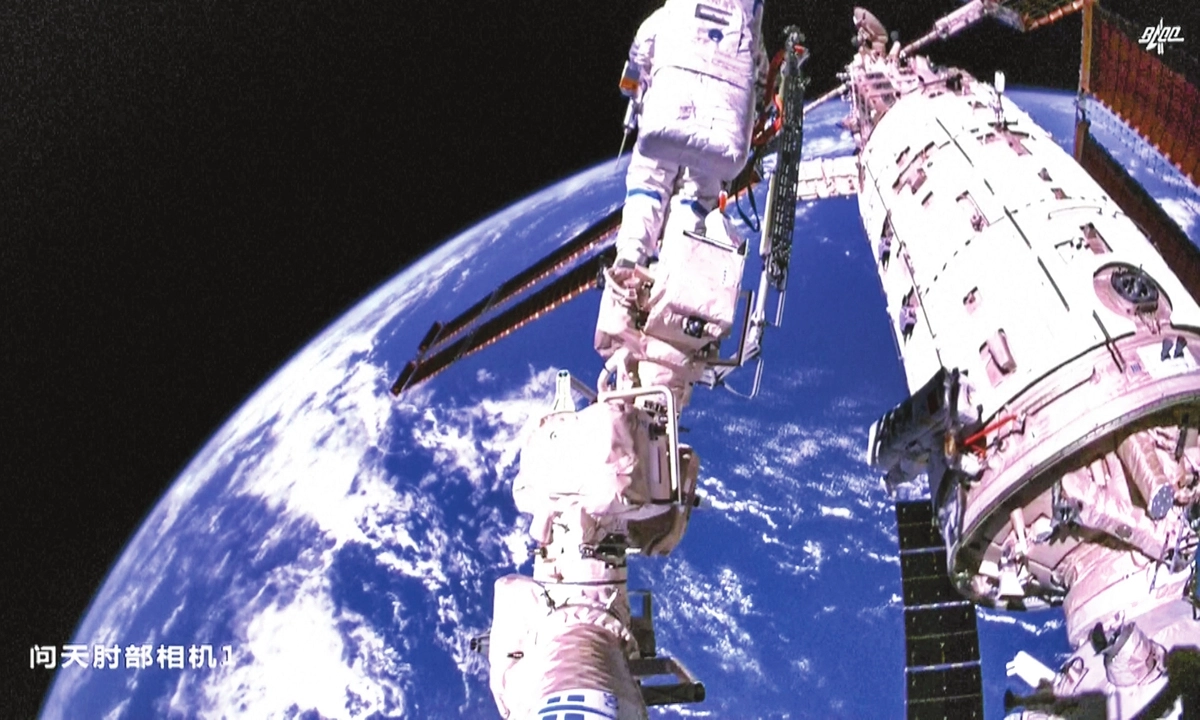Nov 17(ABC): The taikonauts of the Shenzhou-14 manned spaceflight mission crew conducted their third spacewalk on Thursday, which marked the first extravehicular activity (EVA) after the China Space Station completed its T-shape basic structure assembly on November 3.
Shenzhou-14 mission commander Chen Dong and his fellow crew member Cai Xuzhe completed all planned tasks during their spacewalk, which lasted five and a half hours on Thursday, and returned to the Wentian lab module at 4:50 pm Beijing time, the Global Times learned from the China Manned Space Agency (CMSA).
The Thursday spacewalk was a full success, which verified the coordination capability of the taikonauts and the robotic arms combination, as well as the performance of the airlock cabin of the Wentian module and other equipment in supporting taikonauts during spacewalks, the CMSA announced.
According to the statement the CMSA provided to the Global Times on Thursday, the spacewalking pair managed to install two sets of connection devices bridging the Tiangong Space Station modules – Wentian lab module, Tianhe core module and Mengtian lab module – and they also elevated the panorama camera on the Wentian lab module and installed a handrail on the small robotic arm.
Female crew member Liu Yang played a supporting role inside the cabin, according to the CMSA.
This was the Shenzhou-14 crew’s third spacewalk, following a first on September 2 and a second on September 17. It also marked the seventh EVA at the China Space Station conducted by taikonauts.
The Global Times learned from mission insiders that the Thursday spacewalk also marked a first in the use of the combination of the large and small robotic arms to support the taikonauts’ activities all over the mega space station combination.
Having been connected to the ends, the combination of the large and small robotic arms could provide a larger operation range for taikonauts that extends to 15 meters, meaning it will be able to cover almost every corner of the space station combination, according to mission insiders.
To form the robotic arm combination with the reach of 15 meters, the 10-meter-long large robotic arm on the Tianhe space station module would rotate to connect with the far end of the 5-meter-long small robotic arm, which is installed on the Wentian lab module, and the other end of the small robotic arm would detach from the Wentian, said Wang Xin, deputy chief command of the space station system with the China Academy of Spacecraft Technology (CAST).
It is not simply a collection of lengths, Wang said, noting the combination demands an even more complicated control strategy and greater stability in its application of supporting taikonauts’ spacewalks, which were verified during the Thursday mission.
With the connection devices being installed between the Wentian module and the Tianhe core module’s node cabin and between the Mengtian module and the Tianhe’s node cabin, respectively, the working area of the taikonauts outside the cabin has expanded from single module to all three modules, the Global Times learned from the CAST.
Also, if a malfunction occurs at the airlock cabin at the Mengtian module, which is the main entry and exit for EVA, taikonauts could move via the connection devices to the node cabin on the Tianhe to enter or exit the China Space Station, according to the CAST.
Each of the two robotic arms has seven degrees of freedom, and they will adopt a separate movement control strategy to ensure stability and precision in their operations, meaning that only one of them is moving during operations, the CAST explained.
Cai executed the first inter-module spacewalk with the help of the newly installed connection devices, the CMSA said, comparing the connection devices between modules as “heavenly bridges. ”
The second space station lab module, the Mengtian, conducted a successful transposition in orbit at 9:32 am Beijing time on November 3, marking the completion of the China Space Station’s T-shape basic structure assembly, a key step toward the completion of the space station.
According to the CMSA, the Shenzhou-14 crew will be visited by the Shenzhou-15 manned spacecraft, and two crews of six taikonauts will make China’s first direct in-orbit handover, before the Shenzhou-14 crew returns to Earth.

